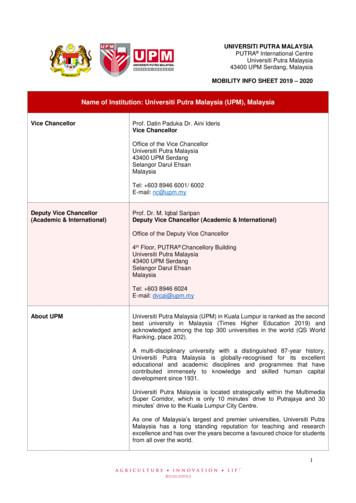The Capital Market In Malaysia - Asian Development Bank
The Capital Market in MalaysiaYutaka ShimomotoYutaka Shimomoto is Economist, Asian Development Bank and Chief Economist, Nikko Securities Co., Ltd. (1997–1999)
Overview mid-1990s when new debt instruments based on Islamic principles were issued.Since 1995, the Government has encouraged private and public entities to issue bonds to raise funds,while BNM has tried to develop market infrastructure to support bond issues. During the financial crisis, some bonds issued by the private sector defaulted,hurting confidence in the market. As the financialcrisis deepened, many listed companies and stockbrokers became distressed and some private debtsecurities defaulted. Thus the capital market in Malaysia is facing serious challenges. The Governmentintroduced measures to curb speculation on foreigncurrency and to restrict the trading of Malaysianequities within KLSE on 1 September 1998, causingtemporary adverse effects on the capital market. Inorder to restore foreign investors’ market confidence,these measures need to be lifted.Capital Market Development The capital market in Malaysia has undergone a robust development since the late 1980s. The delistingof Malaysian and Singaporean companies from theirrespective stock exchanges at the end of 1989 wasa milestone in the development of Malaysia’s equitymarket. With the proliferation of privatization projectsand the equity boom in 1993, market capitalizationexceeded that of Singapore by the mid-1990s, making the Malaysian market one of the fastest growingin the region.The equity market has contributed to the development of the private sector, with initial public offerings (IPOs) and issuances of new shares enablingmany companies to obtain cheap financing. Equityinvestments by individual, institutional, and foreigninvestors increased substantially, and market infrastructure was developed accordingly. Computerizedtrading, electronic clearing and settlement, and central depository systems were in place by the end of1997. The regulators, the Kuala Lumpur Stock Exchange (KLSE) and Securities Commission (SC),have been improving standards on transparency, disclosure, accounting, and corporate governance. Butthese standards still fall short of international standards, as was revealed, for instance, by the RenongUnited Engineers (Malaysia) (UEM) case in November 1997, resulting in a loss of market confidence.Meanwhile, various steps were taken in the late1980s to develop the bond market. Initially, effortswere focused on Government and Cagamas bonds.The central bank, Bank Negara Malaysia (BNM),played an important role in introducing the principaldealer and auction systems to develop the secondary market for these bonds. However, BNM’s attempts were only partially successful. The statutoryrequirements for holding Government and Cagamasbonds have impeded market development. Moreover,the lack of benchmark yield curve and the issue ofriba (interest) had serious implications for bond market development. The latter was addressed in the Introduction A STUDY OF FINANCIAL MARKETS 80As Singapore was once part of Malaysia, companies in these two countries listed on both KLSE andthe Stock Exchange of Singapore (SES) until the endof 1989. Since then, KLSE has taken various measures, including the introduction of computerized trading, a central depository, and efficient clearing andsettlement systems, to develop market infrastructure.In addition, the regulatory framework has been reviewed to promote IPOs and equity investments bydomestic and foreign investors. As a result, somebig privatized companies (e.g., Telekom MalaysiaBerhad and Tenaga Nasioni Berhad [TNB]) werelisted on KLSE, making it one of
unlisted PDS (1996), an auction system for the PDS primary market (1996), and a bond information and dissemination system (1997). Despite Government efforts, a lack of benchmark yield curve hinders the development of the bond market. Financial Crisis and the Capital Market The financial cris
Silat is a combative art of self-defense and survival rooted from Matay archipelago. It was traced at thé early of Langkasuka Kingdom (2nd century CE) till thé reign of Melaka (Malaysia) Sultanate era (13th century). Silat has now evolved to become part of social culture and tradition with thé appearance of a fine physical and spiritual .
May 02, 2018 · D. Program Evaluation ͟The organization has provided a description of the framework for how each program will be evaluated. The framework should include all the elements below: ͟The evaluation methods are cost-effective for the organization ͟Quantitative and qualitative data is being collected (at Basics tier, data collection must have begun)
On an exceptional basis, Member States may request UNESCO to provide thé candidates with access to thé platform so they can complète thé form by themselves. Thèse requests must be addressed to esd rize unesco. or by 15 A ril 2021 UNESCO will provide thé nomineewith accessto thé platform via their émail address.
̶The leading indicator of employee engagement is based on the quality of the relationship between employee and supervisor Empower your managers! ̶Help them understand the impact on the organization ̶Share important changes, plan options, tasks, and deadlines ̶Provide key messages and talking points ̶Prepare them to answer employee questions
Dr. Sunita Bharatwal** Dr. Pawan Garga*** Abstract Customer satisfaction is derived from thè functionalities and values, a product or Service can provide. The current study aims to segregate thè dimensions of ordine Service quality and gather insights on its impact on web shopping. The trends of purchases have
Chính Văn.- Còn đức Thế tôn thì tuệ giác cực kỳ trong sạch 8: hiện hành bất nhị 9, đạt đến vô tướng 10, đứng vào chỗ đứng của các đức Thế tôn 11, thể hiện tính bình đẳng của các Ngài, đến chỗ không còn chướng ngại 12, giáo pháp không thể khuynh đảo, tâm thức không bị cản trở, cái được
UNIVERSITI PUTRA MALAYSIA PUTRA International Centre Universiti Putra Malaysia 43400 UPM Serdang, Malaysia MOBILITY INFO SHEET 2019 – 2020 Name of Institution: Universiti Putra Malaysia (UPM), Malaysia Vice Chancellor Prof. Datin Paduka Dr. Aini Ideris Vice Chancellor Office of the Vice Chancellor
Le genou de Lucy. Odile Jacob. 1999. Coppens Y. Pré-textes. L’homme préhistorique en morceaux. Eds Odile Jacob. 2011. Costentin J., Delaveau P. Café, thé, chocolat, les bons effets sur le cerveau et pour le corps. Editions Odile Jacob. 2010. Crawford M., Marsh D. The driving force : food in human evolution and the future.























